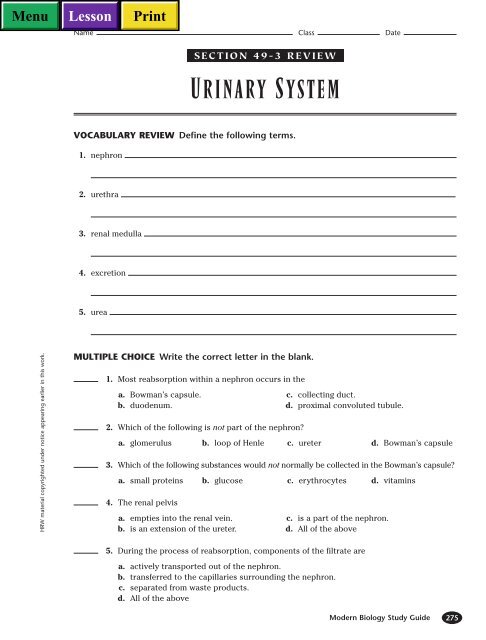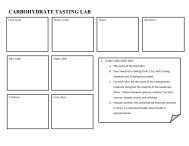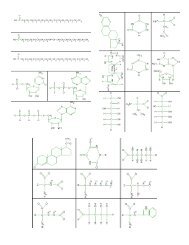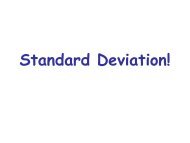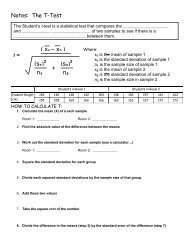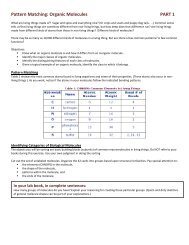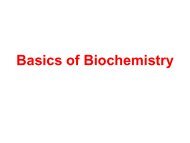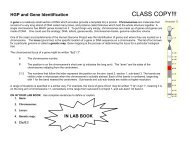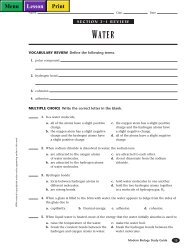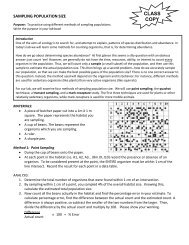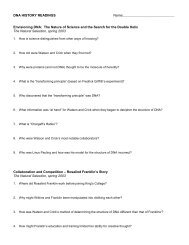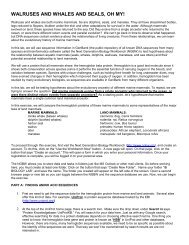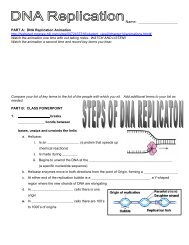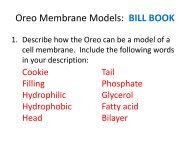URINARY SYSTEM - Biology for Life
URINARY SYSTEM - Biology for Life
URINARY SYSTEM - Biology for Life
Create successful ePaper yourself
Turn your PDF publications into a flip-book with our unique Google optimized e-Paper software.
HRW material copyrighted under notice appearing earlier in this work.<br />
Name Class Date<br />
SECTION 49-3 REVIEW<br />
<strong>URINARY</strong> <strong>SYSTEM</strong><br />
VOCABULARY REVIEW Define the following terms.<br />
1. nephron<br />
2. urethra<br />
3. renal medulla<br />
4. excretion<br />
5. urea<br />
MULTIPLE CHOICE Write the correct letter in the blank.<br />
1. Most reabsorption within a nephron occurs in the<br />
a. Bowman’s capsule.<br />
b. duodenum.<br />
2. Which of the following is not part of the nephron?<br />
a. glomerulus b. loop of Henle c. ureter d. Bowman’s capsule<br />
3. Which of the following substances would not normally be collected in the Bowman’s capsule?<br />
a. small proteins b. glucose c. erythrocytes d. vitamins<br />
4. The renal pelvis<br />
a. empties into the renal vein.<br />
b. is an extension of the ureter.<br />
5. During the process of reabsorption, components of the filtrate are<br />
a. actively transported out of the nephron.<br />
b. transferred to the capillaries surrounding the nephron.<br />
c. separated from waste products.<br />
d. All of the above<br />
c. collecting duct.<br />
d. proximal convoluted tubule.<br />
c. is a part of the nephron.<br />
d. All of the above<br />
Modern <strong>Biology</strong> Study Guide<br />
275
Name Class Date<br />
SHORT ANSWER Answer the questions in the space provided.<br />
1. Describe the importance of filtration in urine production.<br />
2. How do the kidneys contribute to homeostasis?<br />
3. Why are nephrons considered the structural and functional units of the kidney?<br />
4. Critical Thinking How is ammonia related to kidney functioning?<br />
STRUCTURES AND FUNCTIONS Use the figure of a nephron and the in<strong>for</strong>mation below<br />
to answer the following questions.<br />
About 99 of every 100 mL of filtrate<br />
are reabsorbed into the blood, and<br />
about 1,500 mL (1.6 qt) of urine are<br />
excreted per day.<br />
a<br />
b<br />
1. Label each part of the figure in the spaces provided.<br />
2. In which structure is the filtrate collected?<br />
3. Based on the amount of urine excreted daily, about how many milliliters of filtrate would be<br />
produced daily by a pair of normally functioning kidneys?<br />
276 Section 49-3 Review<br />
c<br />
d<br />
e<br />
f<br />
HRW material copyrighted under notice appearing earlier in this work.
HRW material copyrighted under notice appearing earlier in this work.<br />
MULTIPLE CHOICE<br />
1. c 2. c 3. a 4. c 5. b<br />
SHORT ANSWER<br />
1. No; most AIDS patients die from opportunistic<br />
infections.<br />
2. Yes; the immune system is able to combat HIV initially.<br />
This period of infection without symptoms<br />
may last up to 10 years following infection.<br />
3. transfer of body fluids through sexual contact,<br />
sharing hypodermic syringes, and receiving infected<br />
organs or blood<br />
4. Yes; HIV particles or infected cells may be found<br />
within the transplanted organs or skin grafts. This<br />
risk is known, and donor organs and grafts are<br />
tested <strong>for</strong> HIV.<br />
STRUCTURES AND FUNCTIONS<br />
1. AIDS began six years after infection.<br />
2. The number of helper T cells has decreased so<br />
much that plasma cells can no longer be stimulated<br />
to produce HIV antibody.<br />
Section 49-1<br />
VOCABULARY REVIEW<br />
1. An organic nutrient contains carbon as one of its<br />
elements. Inorganic nutrients do not contain carbon.<br />
2. An unsaturated fat is a fatty acid that that has at<br />
least one double bond between carbon atoms.<br />
3. Dehydration causes the fluid volume of the body<br />
to decrease. Water moves from intercellular<br />
spaces to blood by osmosis. Eventually water is<br />
drawn from the cells. As water is drawn the cytoplasm<br />
becomes more concentrated until the cell<br />
can no longer function. Dehydration also impairs<br />
the body’s ability to regulate its temperature.<br />
4. Vitamins function as coenzymes; that is, they activate<br />
enzymes and help them function.<br />
MULTIPLE CHOICE<br />
1. d 2. a 3. d 4. c 5. c<br />
SHORT ANSWER<br />
1. Essential amino acids are those amino acids that<br />
must be obtained from food. Nonessential amino<br />
acids can be produced by the body.<br />
2. Simple sugars are important because they represent<br />
the final carbohydrate that must be <strong>for</strong>med be<strong>for</strong>e<br />
absorption into the bloodstream, and the other carbohydrates<br />
must be metabolized to simple sugars<br />
be<strong>for</strong>e they can be used <strong>for</strong> energy production.<br />
3. Water is important because it is a medium <strong>for</strong><br />
enzymatic reactions, it constitutes 90% of blood<br />
volume, it is used in cellular waste removal, and it<br />
helps regulate body temperature.<br />
4. Nutrients are required <strong>for</strong> proper function and<br />
growth.<br />
STRUCTURES AND FUNCTIONS<br />
1. group a, the carbohydrates<br />
2. group c, animal products. No, essential amino acids<br />
are also obtained from plant products and legumes.<br />
Section 49-2<br />
VOCABULARY REVIEW<br />
1. The stomach, molars, and hard palate are involved<br />
with mechanical digestion, or the physical breakdown<br />
of food into small, easily digestible particles.<br />
2. Gastric pits, gastric fluid, and saliva are involved<br />
with chemical digestion, or the breakdown of food<br />
into usable <strong>for</strong>ms by enzymes.<br />
3. Peristalsis is the series of rhythmic muscle contractions<br />
that moves a bolus, or a ball, through<br />
the esophagus.<br />
4. The liver secretes bile into the gallbladder.<br />
5. Absorption is the process during which the end<br />
products of digested chyme are transferred from<br />
the small intestine to the circulatory system.<br />
MULTIPLE CHOICE<br />
1. b 2. d 3. b 4. c 5. c<br />
SHORT ANSWER<br />
1. Mucus protects the stomach’s inner lining from<br />
the digestive secretions.<br />
2. Pepsin, a protease, catalyzes the breakdown of<br />
proteins to peptides.<br />
3. The pancreas secretes pancreatic fluid into the<br />
small intestine. Pancreatic fluid assists in buffering<br />
the chyme and has enzymes that hydrolyze disaccharides<br />
into monosaccharides, fats into fatty<br />
acids and glycerol, and proteins into amino acids.<br />
4. The richest supply of blood capillaries should be<br />
in the walls of the small intestine, specifically the<br />
ileum and jejunum. These are the areas where the<br />
absorption of the digested nutrients occurs. To<br />
facilitate the absorption, a rich network of blood<br />
capillaries is present in the small intestine.<br />
STRUCTURES AND FUNCTIONS<br />
1. a, esophagus; b, liver; c, large intestine; d, rectum;<br />
e, mouth; f, stomach; g, small intestine<br />
2. The liver stores glycogen, breaks down toxic substances,<br />
and secretes bile, which digests fats.<br />
3. Absorption takes place in the small intestine,<br />
where villi and microvilli greatly increase the surface<br />
area.<br />
Section 49-3<br />
VOCABULARY REVIEW<br />
1. The nephron is the functional unit of the kidney<br />
where urine is produced.<br />
2. The urethra is the tube through which urine<br />
passes from the urinary bladder out of the body.<br />
3. The renal medulla is the inner two-thirds of<br />
the kidney.<br />
4. Excretion is the process of removing metabolic<br />
wastes from the body. Students may also include<br />
that during excretion, the metabolic wastes pass<br />
through a membrane to leave the body.<br />
5. Urea is a nitrogenous waste that is produced<br />
from ammonia by the liver and then is removed<br />
by the kidneys.<br />
MULTIPLE CHOICE<br />
1. d 2. c 3. c 4. b 5. d<br />
SHORT ANSWER<br />
1. Filtration is the initial step in urine <strong>for</strong>mation. This<br />
is when small compounds, including nitrogenous<br />
waste products, are separated from the blood and<br />
transferred to the nephron.<br />
2. Kidneys assist in the maintenance of fluid volume,<br />
blood pH, and the chemical composition of fluids.<br />
3. The entire renal cortex and medulla are composed<br />
of nephrons. Nephrons are considered the<br />
functional units of the kidney because they<br />
Modern <strong>Biology</strong> Study Guide Answer Key<br />
41
per<strong>for</strong>m all of the processes required <strong>for</strong> urine<br />
production.<br />
4. Ammonia is the first step in the production of<br />
urea, which is excreted by kidneys.<br />
STRUCTURES AND FUNCTIONS<br />
1. a, proximal convoluted tubule; b, loop of Henle;<br />
c, Bowman’s capsule; d, glomerulus; e, distal<br />
convoluted tubule; f, collecting duct<br />
2. The filtrate is collected in the Bowman’s capsule.<br />
3. 150,000 mL per day.<br />
Section 50-1<br />
VOCABULARY REVIEW<br />
1. The corpus callosum is the dense band of axons<br />
that connects the cerebral hemispheres.<br />
2. The brain and spinal cord make up the central<br />
nervous system.<br />
3. White matter consists of the axons of neurons.<br />
4. Efferent neurons carry in<strong>for</strong>mation away from the<br />
central nervous system. Motor neurons are efferent<br />
neurons.<br />
5. The diencephalon consists of the hypothalamus<br />
and thalamus.<br />
MULTIPLE CHOICE<br />
1. a 2. b 3. d 4. d 5. c<br />
SHORT ANSWER<br />
1. The limbic system functions in emotion, memory,<br />
motivation, and other social behaviors.<br />
2. The four major lobes of the brain are the frontal,<br />
parietal, occipital, and temporal lobes.<br />
3. Meninges are the three protective layers that surround<br />
the central nervous system. Cerebrospinal<br />
fluid is located between the inner (pia mater) and<br />
middle (arachnoid) meninges and in the ventricles.<br />
Together the meninges and cerebrospinal<br />
fluid <strong>for</strong>m a protective cushion and covering <strong>for</strong><br />
the neurons of the brain and spinal cord.<br />
4. The ventral roots contain the axons of efferent<br />
neurons (motor neurons), which carry in<strong>for</strong>mation<br />
away from the central nervous system.<br />
5. Answers may vary but may include lesion studies;<br />
brain-imaging techniques like PET, CT, and MRI;<br />
behavioral and cognitive studies; electrical recording<br />
techniques; and others.<br />
STRUCTURES AND FUNCTIONS<br />
1. structure A, the gray matter<br />
2. It would eliminate sensory input to the spinal cord<br />
from that spinal nerve.<br />
3. It would eliminate sensory input and motor output<br />
to and from the spinal cord from that spinal nerve.<br />
Section 50-2<br />
VOCABULARY REVIEW<br />
1. The autonomic nervous system consists of the<br />
sympathetic and parasympathetic divisions.<br />
2. The somatic nervous system and the autonomic<br />
nervous system are the two independent components<br />
of the motor division of the peripheral nervous<br />
system.<br />
3. A reflex is an involuntary, generally self-protective<br />
movement. A spinal reflex is a type of reflex that<br />
involves only neurons of the body and the spinal<br />
cord.<br />
42<br />
Modern <strong>Biology</strong> Study Guide Answer Key<br />
4. The motor division is a component of the peripheral<br />
nervous system.<br />
MULTIPLE CHOICE:<br />
1. b 2. c 3. c 4. b 5. c<br />
SHORT ANSWER<br />
1. In a state of physical or emotional stress, the sympathetic<br />
division of the autonomic nervous system<br />
redirects blood flow from the digestive system<br />
toward the heart and skeletal muscles—the “fightor-flight”<br />
response.<br />
2. The autonomic nervous system is most important<br />
<strong>for</strong> homeostasis because it acts constantly and involuntarily<br />
to modulate the body’s internal conditions.<br />
3. control of the skeletal muscles<br />
4. No; the central and peripheral nervous systems<br />
constantly interact. The spinal cord constantly<br />
relays in<strong>for</strong>mation to the brain from the body and<br />
from the brain to the body.<br />
STRUCTURES AND FUNCTIONS<br />
1. The sensory (pain) receptor is located in the hand.<br />
2. The biceps would contract to flex the arm.<br />
3. The triceps (extensor muscles) would be inhibited<br />
during the reflex.<br />
Section 50-3<br />
VOCABULARY REVIEW<br />
1. Dendrites are extensions of neurons that receive<br />
signals from other neurons.<br />
2. Axon terminals are the ends of axons.<br />
3. An action potential is the transmission of an electrical<br />
impulse along the axon of a neuron.<br />
4. A neurotransmitter is a chemical that is released<br />
from axon terminals at synapses and that transmits<br />
an electrical signal between neurons.<br />
5. A synaptic cleft is the gap between adjacent neurons<br />
across which neurotransmitters diffuse in<br />
chemical synaptic transmission.<br />
MULTIPLE CHOICE<br />
1. c 2. b 3. c 4. d 5. d<br />
SHORT ANSWER<br />
1. A neurotransmitter can either increase or<br />
decrease the activity of a postsynaptic neuron,<br />
depending on the ion channels that are activated<br />
by the neurotransmitter.<br />
2. At resting potential, potassium ions are more concentrated<br />
inside the cell, whereas sodium ions are<br />
more concentrated outside the cell.<br />
3. Action potentials conduct down an axon away<br />
from the cell body and toward the axon terminal<br />
because of the refractory period, the period of<br />
time during which sodium channels cannot open<br />
after an action potential.<br />
4. Because ions cannot pass through the myelin<br />
sheath, myelin increases the speed of the action<br />
potential because the electrical impulse must “jump”<br />
from node to node as it moves down the axon.<br />
STRUCTURES AND FUNCTIONS<br />
1. At the resting potential, voltage-gated sodium<br />
channels are not open. Thus, sodium ions cannot<br />
diffuse into the neuron.<br />
2. Figure b shows the conduction of an action potential<br />
down the axon. Sodium ions are flowing into<br />
the cell, reversing the polarity of the cell.<br />
HRW material copyrighted under notice appearing earlier in this work.


